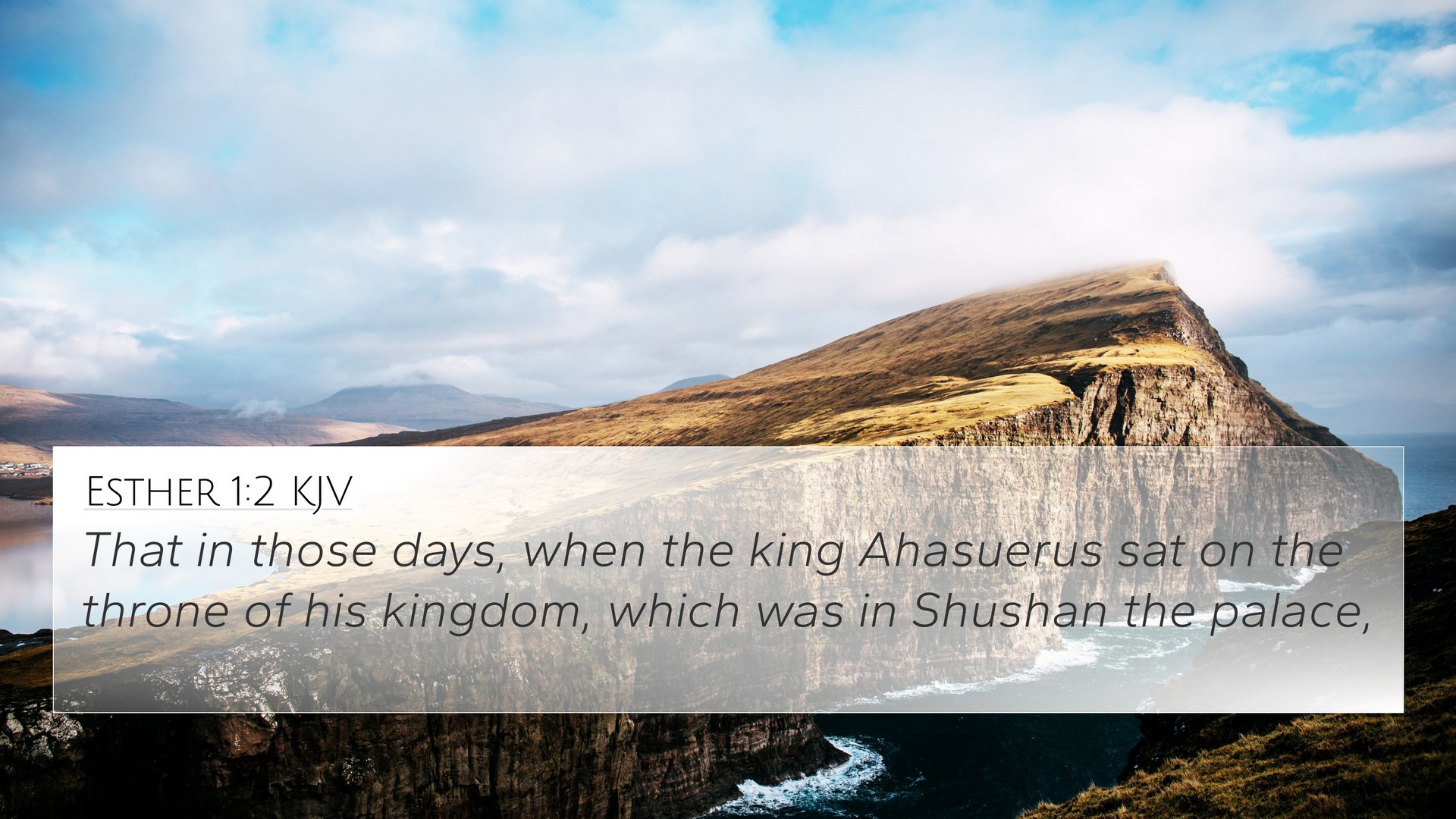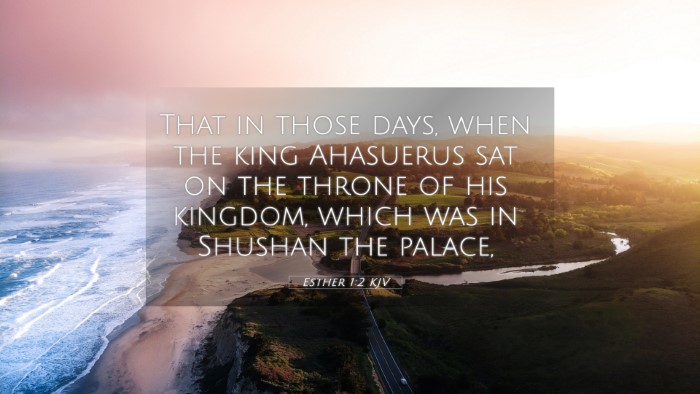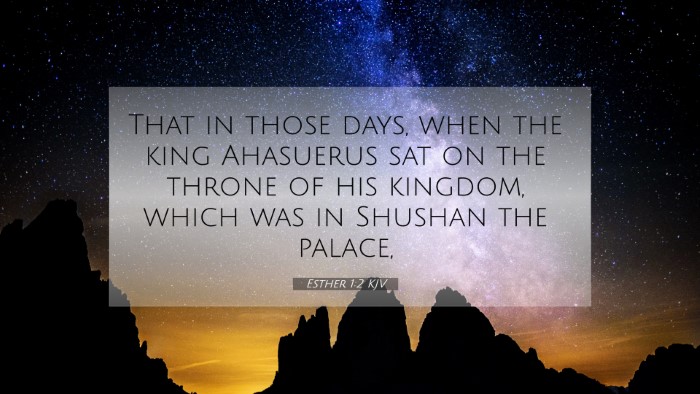Old Testament
Genesis Exodus Leviticus Numbers Deuteronomy Joshua Judges Ruth 1 Samuel 2 Samuel 1 Kings 2 Kings 1 Chronicles 2 Chronicles Ezra Nehemiah Esther Job Psalms Proverbs Ecclesiastes Song of Solomon Isaiah Jeremiah Lamentations Ezekiel Daniel Hosea Joel Amos Obadiah Jonah Micah Nahum Habakkuk Zephaniah Haggai Zechariah MalachiEsther 1:2 Similar Verses
Esther 1:2 Cross References
That in those days, when the king Ahasuerus sat on the throne of his kingdom, which was in Shushan the palace,
Uncover the Rich Themes and Topics of This Bible Verse
Listed below are the Bible themes associated with Esther 1:2. We invite you to explore each theme to gain deeper insights into the Scriptures.
Esther 1:2 Cross Reference Verses
This section features a detailed cross-reference designed to enrich your understanding of the Scriptures. Below, you will find carefully selected verses that echo the themes and teachings related to Esther 1:2 KJV. Click on any image to explore detailed analyses of related Bible verses and uncover deeper theological insights.

Nehemiah 1:1 (KJV) »
The words of Nehemiah the son of Hachaliah. And it came to pass in the month Chisleu, in the twentieth year, as I was in Shushan the palace,
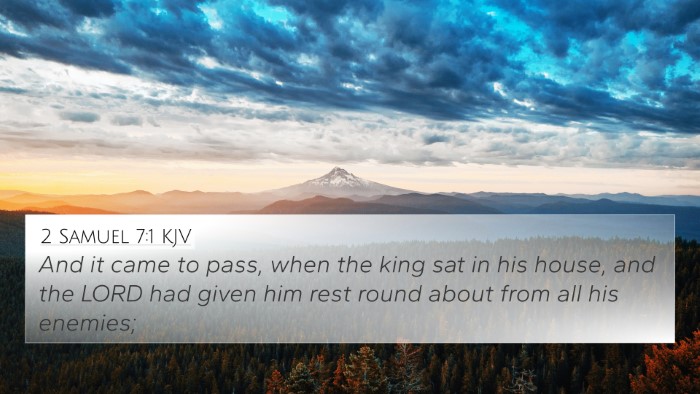
2 Samuel 7:1 (KJV) »
And it came to pass, when the king sat in his house, and the LORD had given him rest round about from all his enemies;
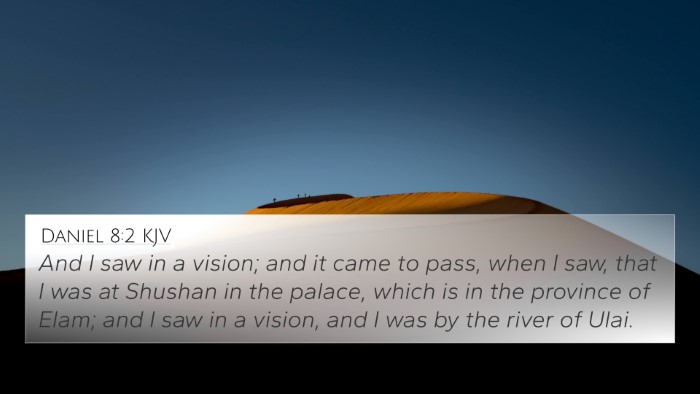
Daniel 8:2 (KJV) »
And I saw in a vision; and it came to pass, when I saw, that I was at Shushan in the palace, which is in the province of Elam; and I saw in a vision, and I was by the river of Ulai.

Esther 2:3 (KJV) »
And let the king appoint officers in all the provinces of his kingdom, that they may gather together all the fair young virgins unto Shushan the palace, to the house of the women, unto the custody of Hege the king's chamberlain, keeper of the women; and let their things for purification be given them:
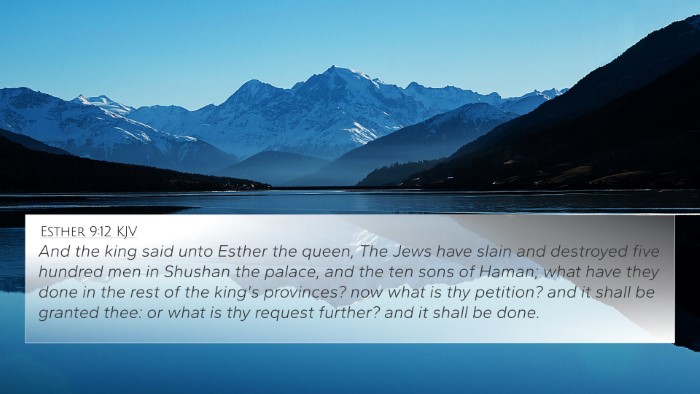
Esther 9:12 (KJV) »
And the king said unto Esther the queen, The Jews have slain and destroyed five hundred men in Shushan the palace, and the ten sons of Haman; what have they done in the rest of the king's provinces? now what is thy petition? and it shall be granted thee: or what is thy request further? and it shall be done.
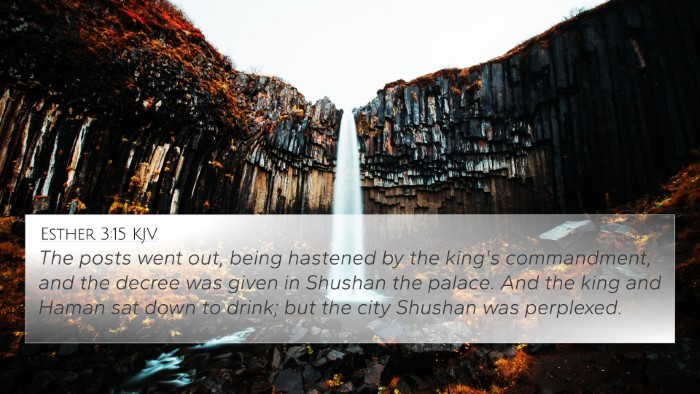
Esther 3:15 (KJV) »
The posts went out, being hastened by the king's commandment, and the decree was given in Shushan the palace. And the king and Haman sat down to drink; but the city Shushan was perplexed.
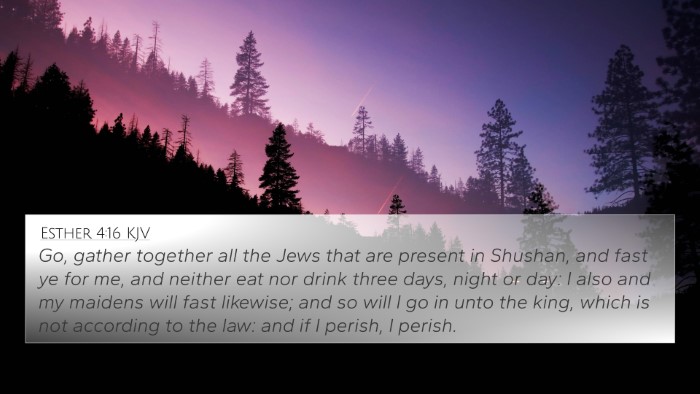
Esther 4:16 (KJV) »
Go, gather together all the Jews that are present in Shushan, and fast ye for me, and neither eat nor drink three days, night or day: I also and my maidens will fast likewise; and so will I go in unto the king, which is not according to the law: and if I perish, I perish.
Esther 1:2 Verse Analysis and Similar Verses
Understanding Esther 1:2
Esther 1:2 states, "That in those days, when King Ahasuerus sat on the throne of his kingdom, which was in Shushan the palace,". This verse opens the Book of Esther by establishing the historical and geographical context of the narrative. Below, we will explore the meaning of this verse through insights drawn from public domain commentaries by Matthew Henry, Albert Barnes, and Adam Clarke, while also identifying its connections with other biblical passages.
Contextual Background
This verse situates us in the time of King Ahasuerus, commonly identified with Xerxes I of Persia, who reigned from 486 to 465 BC. The choice of Shushan (or Susa) as the setting is significant because it was one of the principal cities of the Persian Empire. Understanding this context helps illuminate the political and cultural background that influences the unfolding events in Esther's narrative.
Commentary Insights
- Matthew Henry: Henry emphasizes the importance of the throne and the king’s rule over the Persian Empire, suggesting that Esther's story takes place during a time of great wealth and prosperity, which sets the stage for the dramatic events that follow. He notes that the prosperity of King Ahasuerus, while seemingly extravagant, serves as a contrast to the providential themes present in Esther's story.
- Albert Barnes: Barnes highlights that the mention of Shushan the palace is essential in understanding the political landscape of the region. He points out that the king’s court was filled with splendor and power, which illustrates the stakes involved in the subsequent narrative of Esther's bravery in approaching the king.
- Adam Clarke: Clarke provides insight into the significance of the palace itself, explaining that it served as a focal point for the narrative. He elaborates on the characteristics of King Ahasuerus, noting both his authority and the potential peril for those who dared to approach him unsummoned, setting the stage for Esther's pivotal role in the story.
Bible Verse Cross-References
Understanding Esther 1:2 is enhanced when we explore its connections with other Bible verses. Here are key cross-references that relate to this text:
- Esther 2:5-7: Establishes Esther's Jewish heritage and her connection to Mordecai, which is vital for the storyline.
- Esther 1:1: Provides additional context about the vastness of Ahasuerus's kingdom.
- Ezra 4:6: Links to the specific historical period of Persian rule.
- Daniel 9:1: Offers insight into the reign of Persian leaders during the time of the Jewish exile.
- Nehemiah 1:1: Demonstrates the influence of Persian politics on the Jewish people.
- Proverbs 21:1: Highlights God's sovereignty over the hearts of kings, relating to Esther's story of divine intervention.
- Acts 2:1: Discusses the principles of gathering in significant places, akin to the royal court.
Connections between Bible Verses
The thematic connections in Esther 1:2 can also be highlighted through the following aspects:
- Esther serves as a critical example of courage, which can be compared to Hebrews 11:23-29, exemplifying faith in difficulties.
- The opulence of Ahasuerus' reign mirrors descriptions of wealth in 1 Chronicles 29:12-13 and Proverbs 8:18.
- Esther's narrative reflects themes of divine provides, akin to Romans 8:28, where all things work for the good of those who love God.
Inter-Biblical Dialogue
The Book of Esther engages in inter-Biblical dialogue through its exploration of Jewish identity in a foreign land. Through cross-referencing with passages in the prophetic books (e.g., Isaiah 43:1 and Jeremiah 29:10-14), we see the themes of God's guidance and providential care emerging throughout history.
Thematic Connections
The themes of God's providence against a backdrop of political power resonate with many other scriptures. Some notable themes include:
- God's Sovereignty: The unfolding of events in Esther supports the notion that God is in control, as seen in Psalms 103:19.
- Faithfulness in Adversity: Esther’s courage echoes the faithfulness seen in the lives of Daniel and his friends (Daniel 3:16-18).
- Justice and Deliverance: The ultimate justice that unfolds in the later chapters of Esther reflects similar themes in books like Psalm 37 and Isaiah 61:8.
Conclusion
Esther 1:2 not only introduces us to significant characters and settings within the narrative but also intersects with numerous other biblical texts that enhance its themes of providence, courage, and identity. Utilizing tools such as a Bible concordance or a cross-reference Bible study guide may help readers delve deeper into understanding the remarkable connections outlined in Scripture. As one explores Esther's story, the interconnectedness of biblical verses becomes evident, encouraging a broader understanding of God's overarching plan in the history of His people.
